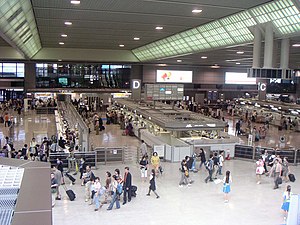Current issues
On April 1, 2004, New Tokyo International Airport was privatized and officially renamed Narita International Airport, reflecting its popular designation since its opening. Following privatization, the airport has reached record traffic levels, and several construction projects are ongoing.
In addition to the ongoing political disputes, which have lessened in severity over the years, arguments over slots and landing fees have plagued the busy airport. Because so many airlines want to use it, the Japanese aviation authorities have limited the number of flights each airline can operate from this airport, making the airport expensive for both airlines and their passengers.
One of the most constant criticisms of the airport has been its distance from central Tokyo—an hour by the fastest train, and often longer by road due to traffic jams. The distance is even more problematic for residents and businesses in west Tokyo and Kanagawa Prefecture, both of which are much closer to Tokyo International Airport (Haneda Airport). The Narita Rapid Railway, scheduled to open in 2010, will alleviate the problem to some extent by shaving 20 minutes off the travel time. Improvements such as the Wangan Expressway have shaved off travel time to Kanagawa Prefecture by bypassing Tokyo.
Several gates at Narita are being refitted with double-decker jetbridges to accommodate the Airbus A380.
Although the Ministry of Land, Infrastructure and Transport has given Narita a monopoly on international air service to the Tokyo region, that monopoly has been gradually weakening. Haneda has had limited international service for some time, beginning with flights to Taiwan and later replaced by flights to Gimpo Airport in Seoul. Following the construction of Haneda's Runway D in 2009, the government aims to transfer other international services to Haneda in order to relieve Narita's congestion and expansion problems. The Ministry of Transport continues to investigate the possibility of building a new reliever airport on an artificial island in Tokyo Bay or off the Kujukuri coast of Chiba Prefecture.[2] Tokyo Governor Shintaro Ishihara has proposed redeveloping Yokota Air Base in western Tokyo as a civil airport.
The future Hyakuri Airfield (Ibaraki Airport), opening in 2009, will relieve traffic for domestic passengers destined to/from Ibaraki and Tochigi Prefectures, and potentially those in Gunma. Technically, the runway here is large enough for jumbo jets. Shizuoka Airport, currently under construction, could take away Numazu-Fuji area passengers that would otherwise come to Narita.
There may be ongoing plans to extend the 2nd runway to 2500m and also taxiway improvement is urgently required in the parallel taxiway "to the letter" in the curved portion only of the administrative subrogation is also being considered. Plans ongoing include a C runway (third runway) is a length of 3200m and a width of 60 m for the construction of the crosswind that have been frozen. The current use of the disused runway are pending contruction to turn it to a runway. Suppose for the crosswind runway is completed if the strong winds from the north-south wind when landing easier. Also, if the weather changes completed by the landing delay decrease in the arrival and departure of efficiency improvement of slots for the increase is to be expected.
Due to environmental concerns raised, in particular from surrounding residents, significant cost in addition to airport construction alone was created. E.g. approx. 40billion Yen for noise protection and 20 billion Yen for electromagnetic protection. In total approx. 320billion Yen have been spent to compensate for environmental impact of the airport since its opening.
